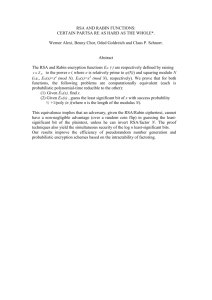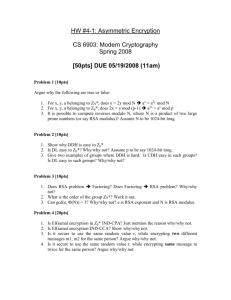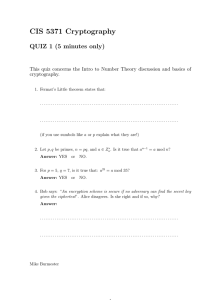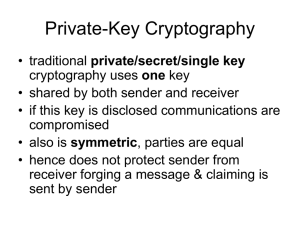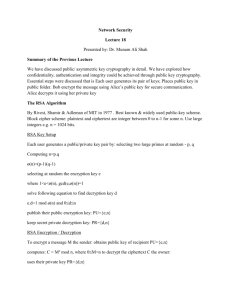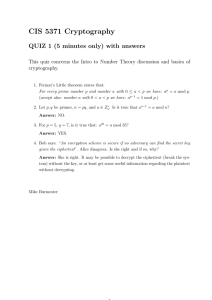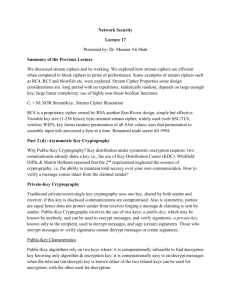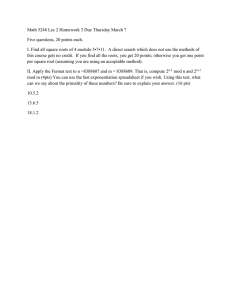Public Key Cryptography and RSA” INCS 741: Cryptography Dr. Monther Aldwairi
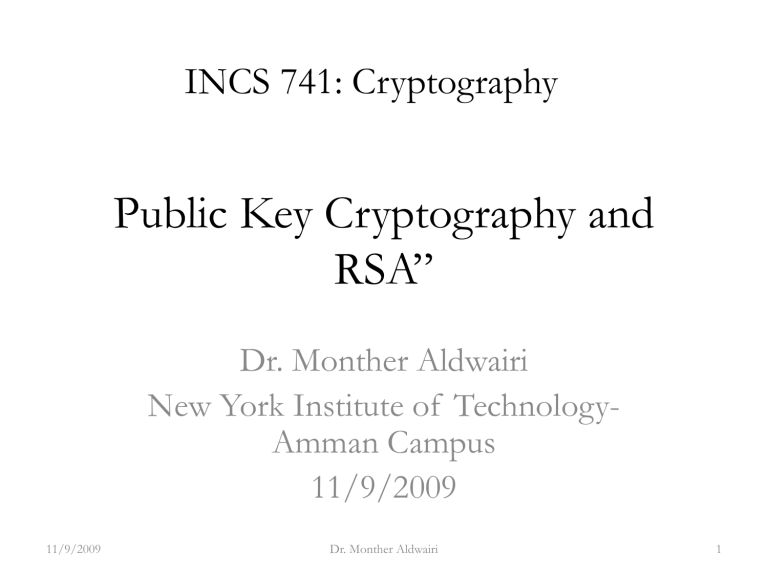
INCS 741: Cryptography
11/9/2009
Public Key Cryptography and
RSA”
Dr. Monther Aldwairi
New York Institute of Technology-
Amman Campus
11/9/2009
Dr. Monther Aldwairi 1
Private-Key Cryptography
• traditional private/secret/single key cryptography uses one key
– shared by both sender and receiver
• if this key is disclosed communications are compromised
• also is symmetric, parties are equal
• hence does not protect sender from receiver forging a message & claiming is sent by sender
Public-Key Cryptography
• probably most significant advance in the 3000 year history of cryptography
– uses two keys – a public & a private key
• asymmetric since parties are not equal
• uses clever application of number theoretic concepts to function
• complements rather than replaces private key
– It is not more, nor less, secure than private key (for both security depends on the key size and computational work to decrypt
Why Public-Key Cryptography?
• developed to address two key issues:
– key distribution – how to have secure communications in general without having to trust a
KDC with your key
– digital signatures – how to verify a message comes intact from the claimed sender
• public invention due to Whitfield Diffie &
Martin Hellman at Stanford Uni in 1976
– known earlier in classified community
Public-Key Cryptography
• public-key/two-key/asymmetric cryptography involves the use of two keys:
– a public-key, which may be known by anybody, and can be used to encrypt messages, and verify signatures
– a private-key, known only to the recipient, used to decrypt
messages, and sign (create) signatures
• is asymmetric because
– those who encrypt messages or verify signatures cannot decrypt messages or create signatures
Public-Key Confidentiality
Public-Key Authentication
Public-Key Characteristics
• Public-Key algorithms rely on two keys where:
– it is computationally infeasible to find decryption key knowing only algorithm & encryption key
– it is computationally easy to en/decrypt messages when the relevant (en/decrypt) key is known
– either of the two related keys can be used for encryption, with the other used for decryption (for some algorithms)
Public-Key Authentication and
Confidentiality
Public-Key Applications
• can classify uses into 3 categories:
– encryption/decryption (provide secrecy)
– digital signatures (provide authentication)
– key exchange (of session keys)
• some algorithms are suitable for all uses, others are specific to one
Public Key Cryptanalysis
• like private key schemes brute force exhaustive search attack is always theoretically possible
– but keys used are too large (>512bits)
• security relies on a large enough difference in difficulty between easy (en/decrypt) and hard
(cryptanalyse) problems
• more generally the hard problem is known, but is made hard enough to be impractical to break
– requires the use of very large numbers
– hence is slow compared to private key schemes
RSA
• by Rivest, Shamir & Adleman of MIT in 1977
• best known & widely used public-key scheme
• based on exponentiation in a finite (Galois) field over integers modulo a prime
– nb. exponentiation takes O((log n) 3 ) operations (easy)
• uses large integers (eg. 1024 bits)
• security due to cost of factoring large numbers
– nb. factorization takes O(e log n log log n ) operations (hard)
RSA Key Setup
• each user generates a public/private key pair by:
• selecting two large primes at random : p, q
• computing their system modulus n=p.q
– note ø(n)=(p-1)(q-1)
• selecting at random the encryption key e
• where 1< e<ø(n), gcd(e,ø(n))=1
• solve following equation to find decryption key d
– e.d=1 mod ø(n) and 0≤d≤n
• publish their public encryption key: PU={e,n}
• keep secret private decryption key: PR={d,n}
RSA Use
• to encrypt a message M the sender:
– obtains public key of recipient PU={e,n}
– computes: C = M e mod n , where 0≤M<n
• to decrypt the ciphertext C the owner:
– uses their private key PR={d,n}
– computes: M = C d mod n
• note that the message M must be smaller than the modulus n (block if needed)
RSA Example - Key Setup
1. Select primes: p =17 & q =11
2. Compute n = pq =17 x 11=187
3. Compute ø( n )=( p– 1)( q1)=16 x 10=160
4. Select e : gcd(e,160)=1; choose e =7
5. Determine d : de= 1 mod 160 and d < 160
Value is d=23 since 23x7=161= 10x160+1
6. Publish public key PU={7,187}
7. Keep secret private key PR={23,187}
RSA Example - En/Decryption
• sample RSA encryption/decryption is:
• given message M = 88 (nb. 88<187 )
• encryption:
C = 88 7 mod 187 = 11
• decryption:
M = 11 23 mod 187 = 88
Why RSA Works
• because of Euler's Theorem:
– m ø(n) mod n = 1 where gcd(m,n)=1
• in RSA have:
– n=p.q
– ø(n)=(p-1)(q-1)
– carefully chose e & d to be inverses mod ø(n)
– hence e.d=1+k.ø(n) for some k
• hence :
C d = M e.d = M 1+k.ø(n) = M 1 .(M ø(n) ) k
= M 1 .(1) k = M 1 = M mod n
Exponentiation
• can use the Square and Multiply Algorithm
• a fast, efficient algorithm for exponentiation
• concept is based on repeatedly squaring base
• and multiplying in the ones that are needed to compute the result
• look at binary representation of exponent
• only takes O(log
2 n) multiples for number n
– eg. 7 5 = 7 4 .7
1 = 3.7 = 10 mod 11
– eg. 3 129 = 3 128 .3
1 = 5.3 = 4 mod 11
Exponentiation
c = 0; f = 1 for i = k downto 0 do c = 2 x c f = (f x f) mod n if b i
== 1 then c = c + 1 f = (f x a) mod n return f
Efficient Encryption
• encryption uses exponentiation to power e
• hence if e small, this will be faster
– often choose e=65537 (2 16 -1)
– also see choices of e=3 or e=17
• but if e too small (eg e=3) can attack
– using Chinese remainder theorem & 3 messages with different modulii
• if e picked first, must ensure gcd(e,ø(n))=1
– ie reject any p or q not relatively prime to e
Efficient Decryption
• decryption uses exponentiation to power d
– this is likely large, insecure if not
• can use the Chinese Remainder Theorem (CRT) to compute mod p & q separately. then combine to get desired answer
– approx 4 times faster than doing directly
• only owner of private key who knows values of p & q can use this technique
RSA Key Generation
• users of RSA must:
– determine two primes at random p, q
– select either e or d and compute the other
• primes p,q must not be easily derived from modulus n=p.q
– means must be sufficiently large
– typically guess and use probabilistic test
• exponents e , d are inverses, so use Inverse algorithm to compute the other
RSA Security
• possible approaches to attacking RSA are:
– brute force key search (infeasible given size of numbers)
– mathematical attacks (based on difficulty of computing ø(n), by factoring modulus n)
– timing attacks (running time of decryption)
– chosen ciphertext attacks (given properties of RSA)
Progress in Factorization
11/9/2009
Number of Decimal Digits
100
110
120
129
130
Approximate Number of Bits
332
365
398
428
431
140
155
160
174
200
465
512
530
576
663
Date Achieved
April 1991
April 1992
June 1993
April 1994
April 1996
February 1999
August 1999
April 2003
December 2003
May 2005
Dr. Monther Aldwairi
MIPS-years
7
75
830
5000
1000
2000
8000
Algorithm
Quadratic sieve
Quadratic sieve
Quadratic sieve
Quadratic sieve
Generalized number field sieve
Generalized number field sieve
Generalized number field sieve
Lattice sieve
Lattice sieve
Lattice sieve
24
Factoring Problem
• mathematical approach takes 3 forms:
– factor n=p.q
, hence compute ø(n) and then d
– determine ø(n) directly and compute d
– find d directly
• currently believe all equivalent to factoring
– have seen slow improvements over the years
• as of May-05 best is 200 decimal digits (663) bit with LS
– biggest improvement comes from improved algorithm
• cf QS to GNFS to LS
– currently assume 1024-2048 bit RSA is secure
• ensure p, q of similar size and matching other constraints
Timing Attacks
• developed by Paul Kocher in mid-1990’s
• exploit timing variations in operations
– eg. multiplying by small vs large number
– or IF's varying which instructions executed
• infer operand size based on time taken
• RSA exploits time taken in exponentiation
• countermeasures
– use constant exponentiation time
– add random delays
– blind values used in calculations
Chosen Ciphertext Attacks
• RSA is vulnerable to a Chosen Ciphertext Attack
(CCA)
– attackers chooses ciphertexts & gets decrypted plaintext back
• choose ciphertext to exploit properties of RSA to provide info to help cryptanalysis
• can counter with random pad of plaintext
• or use Optimal Asymmetric Encryption Padding
(OASP)
CCA Example
• Assume we have C=M e mod n To decrypt
• Compute X=C • 2 e mod n
• Decrypt X Y= X d mod n
• But
X= (C mod n) • (2 e mod n)
C=M e
X= (M e mod n) • (2 e mod n)
X= ((2M) e mod n)
Y=2M
Summary
• have considered:
– principles of public-key cryptography
– RSA algorithm, implementation, security
